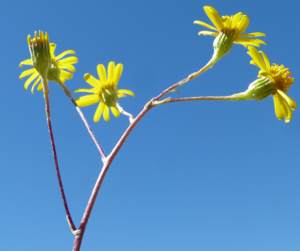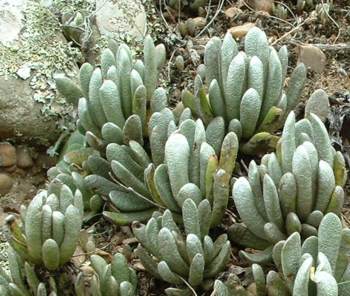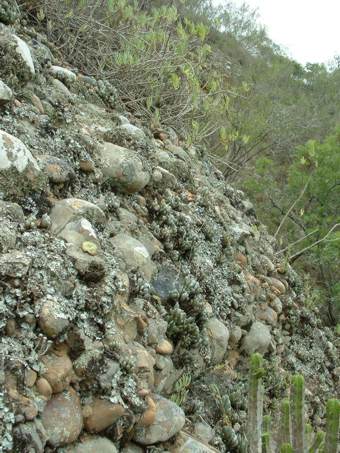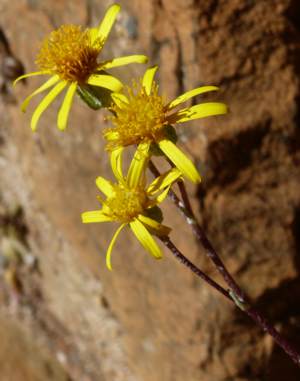Caputia scaposa
Caputia scaposa (DC.) B.Nord. & Pelser (=Senecio scaposus DC.)
Family: Asteraceae
Common names: small caputia (Eng.); kleintontelbos (Afr.)
Introduction
This is a short, drought tolerant, succulent shrublet, belonging to the daisy family (Asteraceae), with showy, spreading leaves in a central rosette and ascending, striking yellow flowers, ideal for the waterwise garden.

Description
Description
Short-stemmed, succulent perennial, branched from the base to form a cluster of up to 12 decumbent to ascending heads. Roots are fibrous. Branches are rounded (terete), 8-15 mm in diameter, covered with the remains of the older leaves. Leaves ascending, alternate in dense rosettes, 45-120 × 8-12 mm, elongate, linear, sub-cylindrical to biconvex, the surface white-felted; the tip is acute or may be blunt, often spoon-shaped (spathulate) or lobed in var. addoensis.

Inflorescences are branched and up to 300-450 mm long, bearing 2-6 ascending heads. Flower heads (capitula) showy, with yellow ray florets up to 35 mm in diameter.
Conservation Status
Status
Caputia scaposa var. scaposa is widespread and common in its habitat and consequently has the status Least Concern (LC) in the Red List of South African Plants (Raimondo et al . 2009). However, due to the rare occurrence of C. scaposa var. addoensis it has been classified as Endangered [B1, ab (iii)], because of its restricted distribution. Plants of var. addoensis and var. scaposa have been well established in cultivation (ex situ conservation) and grown by succulent plant enthusiasts.

Distribution and habitat
Distribution description
Two varieties of Caputia scaposa are recognised; var. scaposa is only known from Badspoort in the Klein Karoo in the Western Cape to the Kei River in the Eastern Cape, growing on sandstone ledges of sheer cliffs or rocky hills mainly in quartzitic, sandstone-derived soils. They are often found on steep slopes, and dry river valleys. The vegetation consists mainly of Albany Thicket, however, at the Kei River it consists of Eastern Valley Bushveld (Mucina et al. 2006). At Badspoort plants grow in Gamka Thicket on sheer cliffs together with other succulents such as Bulbine ramosa, Tylecodon leucothrix, Albuca thermarum and Tromotriche choanantha.

Along the Kei River at its easternmost distribution, plants grow on cliffs sharing their habitat with Gasteria excelsa, Huernia pendula, Cotyledon woodii and Adromischus liebenbergii subsp. orientalis. At the Kouga Dam, plants were observed growing in Gamtoos Thicket on cliffs with Aloe pictifolia, Cotyledon tomentosa, Haworthia viscosa and Gasteria glomerata.
Var. adoensis grows near Addo and Enon in the Eastern Cape in Sundays Thicket. Var. caulescens has stems longer than 4 cm and with spoon-shaped leaf tips. The latter from near Enon, Eastern Cape.
Caputia scaposa is closely related to Caputia tomentosa with similar silvery white leaves, however the latter is a spreading, shrubby plant.
This species grows unarmed but finds it protection from the sheer cliffs. Although rain falls mainly in summer and winter and ranges from 250 -400 mm per annum, there is a tendency toward winter dryness. The average annual daily maximum temperature is about 24°C and the average daily minimum about 12°C. Caputia scaposa grows at an altitude of 100 -4 00m. The soil is sandy, mineral poor and acidic. The plants grow in full sun or light shade, the dense silvery hairs reflect the sun, an adaptation to the dry conditions.

Derivation of name and historical aspects
History
The well-known naturalist and traveller W.J. Burchell (1781 - 1863) first collected this species between Bethelsdorp and Uitenhage in December 1813 (Dyer 1931; Gunn & Codd 1981). The other well-known travelling horticulturist from Kew, James Bowie (1789 - 1869), collected and sent live plants to the Royal Botanical Garden at Kew and it was soon featured in the Botanical Magazine (69, t. 4011) in 1843, under the name Senecio calamifolius. The generic name Caputia was established by the Swedes, Bertil Nordenstam and Pieter Pelser in 2012, an allusion to its geographical origin (Nordenstam & Pelser 2012). The species name scaposa is from the Latin and pertains to the elongated lower portion of the inflorescence.

Ecology
Ecology
Caputia scaposa flowers in autumn and winter (April to July) and is pollinated by insects. The seeds ripen in autumn and are dispersed by wind.
Uses
Use
Apart from its horticultural use, the plants do not have recorded economic benefits and are not used medicinally.
Growing Caputia scaposa
Grow
Caputia scaposa is fairly slow growing, forming dense clusters. It is an attractive species for its silver leaves which are very striking, and best grown in containers or in Thicket or Succulent Karoo gardens in sunny situations (Van Jaarsveld 2010). It also thrives in Mediterranean-type gardens in Europe and California (USA) where frost is not severe. This species is easily propagated by division or cuttings. It prefers full sun, however, when grown in slightly shady conditions, the leaves tend to be elongated and greener. The soil should be well drained and plants grow best in a rockery on a sunny slope.
Caputia scaposa is easily propagated from stem cuttings. It is best to allow the stem cuttings to form a heel, by placing them on a dry window sill for one to three weeks. Cuttings are best rooted in a small container in a well-drained medium. Grow in sand or gravel and place in a warm sunny position. Cuttings can be taken throughout the year but spring or summer are best, when cuttings should rapidly root within three or four weeks. Once rooted, they can be planted out in a sunny, well-drained spot in the garden. Best to feed plants with an organic fertiliser (compost or any other liquid fertiliser). Although Caputia scaposa can be watered at any time of the year, watering should be reduced in winter.
References
- Dyer, R.A. 1931. Senecio scaposus. Flowering Plants of Africa . Plate no 434
- Gunn, M. & Codd, L.E. 1981. Botanical exploration of southern Africa . Balkema, Cape Town.
- Mucina, L. & Rutherford, M.C. (eds). 2006. The vegetation of South Africa, Lesotho and Swaziland. Strelitzia 19. South African National Biodiversity Institute, Pretoria.
- Nordenstam, B.E. & Pelser P.B. 2012. Caputia , a new genus to accommodate four succulent South African Senecioneae (Compositae) species. Compositae Newsletter 50: 56 - 69.
- Raimondo, D., Von Stad i en, L., Foden, W., Victor, J.E., Helme, N.A., Turner, R.C., Kamundi, D.A. & Manyama, P.A. (eds.). 2009. Red List of South African plants 2009. Strelitzia 25. South African National Biodiversity Institute, Pretoria.
- Rowley, G.D. 1994. Succulent Compositae . Strawberry Press, Mill Valley, California.
- Van Jaarsveld, E.J. 2010. Water Wise Gardening . Struik, Cape Town.
Credits
Erst van Jaarsveld
Kirstenbosch National Botanical Garden
September 2014
Plant Attributes:
Plant Type: Shrub, Succulent
SA Distribution: Eastern Cape
Soil type: Sandy, Loam
Flowering season: Spring, Winter
PH: Acid, Neutral
Flower colour: Yellow
Aspect: Full Sun
Gardening skill: Average
Special Features:
Horticultural zones










Rate this article
Article well written and informative
Rate this plant
Is this an interesting plant?
Login to add your Comment
Back to topNot registered yet? Click here to register.